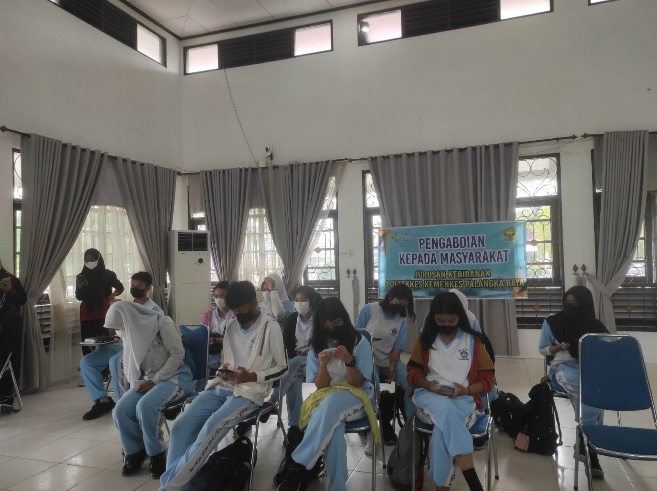Edukasi Kesehatan Reproduksi Remaja dalam Upaya Mencegah Perilaku Seksual Berisiko di Kota Palangka Raya
https://doi.org/10.33860/pjpm.v5i1.2127
Keywords:
adolescence, health reproductive, sexualityAbstract
Adolescence is a transition period towards adulthood. During this period, risky sexual behavior often occurs. Palangka Raya is the capital of Central Kalimantan Province which is the third highest in child marriages in Indonesia. Information and education regarding inappropriate and correct sexuality as well as hidden messages in exposure to media containing pornographic content will increase teenagers' interest in premarital sex which can increase cases of child marriage. This community service activity aims to provide education to teenagers to understand reproductive health so that they can prevent and avoid risky sexual behavior. The method of implementing the activity is by giving a pretest, providing education about reproductive health and preventing risky sexual behavior in two stages, discussion and giving a posttest about adolescent knowledge about reproductive health to 30 activity participants. This activity was carried out at the Antang Bajenta youth posyandu in September 2022. The results of the activity showed that there was an increase in knowledge in the good category, from 13.3% to 76.7%. The conclusion is that this activity can increase teenagers' knowledge by 63.4%. It is hoped that this programs can be carried out regularly by health workers both at school and outside school, such as at youth posyandu and other youth activities.
References
Annah I, Sukriani W, Febriani I. 2022. Informasi Kesehatan Reproduksi Terhadap Perilaku Berpacaran Remaja Di Provinsi Kalimantan Tengah, Indonesia. Journal of Nursing and Public Health, 10(2): 108–116. https://doi.org/10.37676/jnph.v10i2.3142.
Beyens I, Keijsers L, Coyne SM. 2022. Social media, parenting, and well-being. Current Opinion in Psychology. The Authors, 47: 101350. https://doi.org/10.1016/j.copsyc.2022.101350.
BPS-Statistics Indonesia. 2020. Statistik Indonesia. Statistical Yearbook of Indonesia, 6(JAN): 784. https://doi.org/10.3389/fpsyg.2015.00002.
Chotimah H, Notoatmodjo S, Agustina S. 2022. Determinan Perilaku Seksual Remaja di SMKK Prima Indonesia - Bekasi. Jurnal Bidang Ilmu Kesehatan, 12(1): 71–82. https://doi.org/10.52643/jbik.v12i1.1573.
Deshmukh DD, Chaniana SS. 2020. Knowledge About Sexual and Reproductive Health in Adolescent School-Going Children of 8th, 9th, and 10th Standards. Journal of Psychosexual Health, 2(1): 56–62. https://doi.org/10.1177/2631831819898916.
Nurdianti R, Marlina L, Sumarni S. 2021. Hubungan Pengetahuan Dengan Perilaku Seksual Pada Remaja Di Smk Mjps 1 Kota Tasikmalaya. Healthcare Nursing Journal, 3(1): 90–96. https://doi.org/10.35568/healthcare.v3i1.1094.
Oktriyanto O, Alfiasari A. 2019. Dating and Premarital Sexual Inisiation on Adolescence in Indonesia. Jurnal Kesehatan Masyarakat, 15(1): 98–108. https://doi.org/10.15294/kemas.v15i1.17270.
Permatasari D, Suprayitno E. 2021. Pendidikan Kesehatan Reproduksi pada Remaja. Jurnal Empathy, 2(1): 1–5. https://doi.org/10.37341/jurnalempathy.v2i1.46.
Puspasari, Sukamdi, Emilia O. 2017. Paparan Informasi Kesehatan Reproduksi Melalui Media Pada Perilaku Seksual Pranikah : Analisis Data Survei Demografi Kesehatan Indonesia 2012. Berita Kedokteran Masyarakat, 33(1): 31–36. https://doi.org/10.22146/bkm.16993
Reynolds C, Sutherland MA, Palacios I. 2019. Exploring the use of technology for sexual health risk-reduction among ecuadorean adolescents. Annals of Global Health, 85(1): 1–10. https://doi.org/10.5334/aogh.35.
Saha R, Paul P, Yaya S, Banke-Thomas A. 2022. Association between exposure to social media and knowledge of sexual and reproductive health among adolescent girls: evidence from the UDAYA survey in Bihar and Uttar Pradesh, India. Reproductive Health. BioMed Central, 19(1): 1–15. https://doi.org/10.1186/s12978-022-01487-7.
Scull TM, Carl AE, Keefe EM, Malik C V. 2022a. Exploring Parent-gender Differences in Parent and Adolescent Reports of the Frequency, Quality, and Content of Their Sexual Health Communication. Journal of Sex Research. Taylor & Francis, 59(1): 122–134. https://doi.org/10.1080/00224499.2021.1936439.
Scull TM, Dodson C V., Geller JG, Reeder LC, Stump KN. 2022b. A Media Literacy Education Approach to High School Sexual Health Education: Immediate Effects of Media Aware on Adolescents’ Media, Sexual Health, and Communication Outcomes. Journal of Youth and Adolescence. Springer US, 51(4): 708–723. https://doi.org/10.1007/s10964-021-01567-0.
Sukriani W, Annah I, Febriani I, Krisnata R, Nasution SL. 2022. Keterpaparan Informasi Kesehatan Reproduksi Terhadap Pengalaman Seksual Remaja. Window of Health : Jurnal Kesehatan, 5(4): 723–734. https://doi.org/10.33096/woh.v5i04.56.
Supit JAM, Lumy FN, Kulas EI. 2019. Promosi Kesehatan Reproduksi Terhadap Pengetahuan Remaja. JIDAN (Jurnal Ilmiah Bidan), 6(2): 46–51. https://doi.org/10.47718/jib.v6i2.820.
UNICEF. 2020. Adolescent development East Asia and Pacific. Retrieved from https://www.unicef.org/eap/what-we-do/adolescent-development.
WHO. 2020. Adolescent health. Retrieved from https://www.who.int/health-topics/adolescent-health#tab=tab_1.
Zakaria M, Karim F, Mazumder S, Cheng F, Xu J. 2020a. Knowledge on, attitude towards, and practice of sexual and reproductive health among older adolescent girls in Bangladesh: An institution-based cross-sectional study. International Journal of Environmental Research and Public Health, 17(21): 1–14. https://doi.org/10.3390/ijerph17217720.
Zakaria Z, Harapan E, Puspita Y. 2020b. The Influence of Learning Facilities and Motivation On Student’s Achievement. International Journal of Progressive Sciences and Technologies (IJPSAT), 20(2): 284–290. http://dx.doi.org/10.52155/ijpsat.v20.2.1826.
Zulu IZ, Zulu JM, Svanemyr J, Michelo C, Mutale W, Sandøy IF. 2022. Application of community dialogue approach to prevent adolescent pregnancy, early marriage and school dropout in Zambia: a case study. Reproductive Health. BioMed Central, 19(1): 1–9. https://doi.org/10.1186/s12978-022-01335-8.

Downloads
Published
How to Cite
Issue
Section
License
Copyright (c) 2024 Wahidah Sukriani, Seri Wahyuni (Author)

This work is licensed under a Creative Commons Attribution-ShareAlike 4.0 International License.
Authors who publish with Poltekita: Jurnal Pengabdian Masyarakat agree to the following terms:
- Authors retain copyright and grant the journal right of first publication with the work simultaneously licensed under a Creative Commons Attribution License (CC BY-SA 4.0) that allows others to share the work with an acknowledgment of the work's authorship and initial publication in this journal.
- Authors are able to enter into separate, additional contractual arrangements for the non-exclusive distribution of the journal's published version of the work (e.g., post it to an institutional repository or publish it in a book), with an acknowledgment of its initial publication in this journal.
- Authors are permitted and encouraged to post their work online (e.g., in institutional repositories or on their website) prior to and during the submission process, as it can lead to productive exchanges, as well as earlier and greater citation of published work.

This work is licensed under a Creative Commons Attribution-Share Alike 4.0 International License
You are free to:
- Share, copy and redistribute the material in any medium or format
- Adapt, remix, transform, and build upon the material for any purpose, even commercially.
- The licensor cannot revoke these freedoms as long as you follow the license terms.

1.png)


